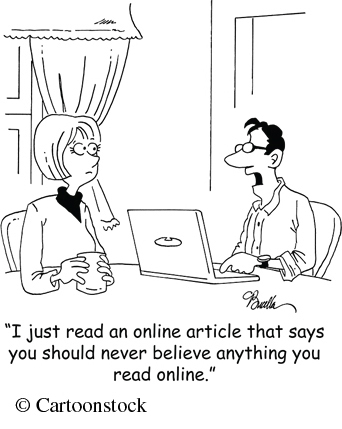Evaluate the Information You’ve Found
Once you’ve found information, you need to evaluate its quality. Evaluation is a key component of critical thinking because it requires higher-level thinking skills. To prompt reflection and analysis, ask yourself questions such as “Can I trust what I’m reading right now?”
ACTIVITY: Bring in examples of acceptable and unacceptable magazines, journal articles, and books. Divide the class into teams, giving each team one of the publications. Have groups decide whether their example is of acceptable or unacceptable quality and explain their reasoning to the class.
In some ways, evaluating the quality of the information you find is like examining the quality of ingredients when you’re baking. Just as you wouldn’t put a rotten apple into a pie, you don’t want to include weak or questionable information in your papers. Recognizing bad information isn’t as easy as picking out a rotten apple, but the strategies in this section can help.
WRITING PROMPT: Ask students to select an article or a book of their choosing and, in a one-page paper, assess the source using the categories listed in this section: basic quality, author credibility, objectivity, and currency.

Basic Quality
Ask some simple questions about the basic quality of the information. When looking at a book, check the name of the publisher. Have you heard of the company? Does the publisher have a well-developed Web site? With the rise of self-publishing, anyone can write and print a book.
If you’re examining a journal article in the library, see if it includes a list of professionals who edit and review articles for the journal. If you’ve found an article through your library’s Web site or another online database, do a quick search to make sure the journal is peer-reviewed.
FURTHER READING: For more information on choosing credible Internet resources, read “Tips and Tricks for Evaluating Web Sites” at the University of Illinois’s Web site, or choose from many other college Web pages. In fact, your own college’s Web site likely has information on this topic.
When you’re evaluating Web sites, trustworthy sources will clearly state who maintains the site and will often be linked to other well-known, respected sites. Sites ending in .edu or .org may be more appropriate for research purposes than .com sites.
Author Credibility
To determine an author’s credibility, investigate the answers to these questions: Do you recognize the author’s name? Has your instructor referred to the author in class, or does the author’s name appear in your textbook? What can you find out about the author’s background and credentials? Is he or she an expert on the topic? As you read the source, ask yourself how well the author has covered the topic. Does he or she seem well informed?
Objectivity
Quality sources maintain objectivity by presenting all sides of an issue. If the author has a particular bias, he or she should make that known. For instance, politically conservative or liberal writers should be up-front about their views. A bias doesn’t mean that the author’s writing is flawed or useless, but you do need to be aware of it and consider how well the author has supported his or her views. If the author merely states a biased view without backing it up, you probably shouldn’t include this information in your paper or presentation.
233
Currency
Check the publication date of books and journals. How current is the information you’re evaluating? How current does it need to be? A description of the Internet written in the mid-1990s might be a great resource for a project on the history of the Internet, but not for a project focused on today’s Internet-related issues. Also check the dates of the citations in articles or books. If the dates of the citations are close to the article’s or book’s date of publication, the authors were using current information. With Web sites, look for the dates when articles were posted and for references to more recent events so that you can see whether the content is refreshed regularly. However, don’t assume that older content is worthless; a thirty-year-old book for a geology class might still be a good source if it’s an important work in the field.
FOR DISCUSSION: Show the class an example of a journal article that contained credible information at the time it was published but is now inaccurate. Discuss the importance of finding up-to-date information.
Wikipedia
Using information from Wikipedia in papers and presentations is a controversial topic on college campuses.1 Information on Wikipedia might be inaccurate or purposefully misleading because anyone can edit content on the site. The people making revisions may or may not be experts on the content they’re altering. With peer-reviewed journal articles or edited textbooks, on the other hand, people who are experts on the subject matter have read and reviewed the information. Peer review doesn’t guarantee complete accuracy, but it does make the information more trustworthy than content in Wikipedia articles.
FURTHER READING: In an article on dailydot.com, EJ Dickson describes how she falsified a Wikipedia article about the author of the children’s book Amelia Bedelia and how this information has now become fact on the Internet (search “EJ Dickson, Wikipedia hoax”). (If you plan to show the article directly to students, note that it references drug use.)
Before you use Wikipedia, follow two rules of thumb. First, investigate the wealth of electronic resources available through your library. Second, ask your instructors for their thoughts about the site. Some may tell you to avoid Wikipedia altogether. Others may say that you can use it as a starting point for research on a topic, but only if you confirm the information through other sources.